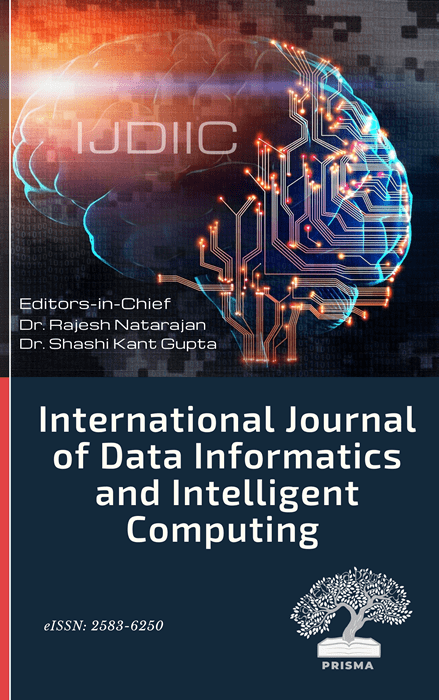Breast Cancer Forecasting Using Machine Learning Algorithms
DOI:
https://doi.org/10.59461/ijdiic.v2i3.72Keywords:
Breast cancer classification , Breast cancer prediction, Benign, Malignant, Support Vector Machine , Random ForestAbstract
Some of the most prevalent and significant causes for malignancies in women is breast cancer. It is presently a widespread health problem, and it has recently become more frequent. The greatest method for managing breast cancer symptoms is early identification. The only kind of cancer that primarily affects women globally is breast cancer, which has the potential to be a major cause of mortality. Early detection of breast cancer is crucial in order to properly treat it and save many lives. This paper covers the results and analyses of several machine learning algorithms for identifying breast cancer. Several machine learning models used the information once it was analyzed. In this paper the Random forests and SVC algorithms were applied and compare the performance of these algorithms. The dataset was taken from UCI repository. Analyze and compare the classifiers' performance in terms of accuracy, precision, and f1-Score in addition. For implementing the ML algorithms, the dataset was split among training and testing phases. The notebook application Jupyter was used to implement these models. When compared to the other two models, it was successfully proven that the SVC model offers the best results. SVC's accuracy of 93% is greater than the method described earlier in that regard. The method used by this model, which will classify cancer into benign and malignant categories, yields the best results.
Downloads
References
S. Malvia, S. A. Bagadi, U. S. Dubey, and S. Saxena, “Epidemiology of breast cancer in Indian women,” Asia. Pac. J. Clin. Oncol., vol. 13, no. 4, pp. 289–295, Aug. 2017, doi: 10.1111/ajco.12661.
Kumar Mohan, Yousuf Fadhil Salim AL-Mamari, and Mohammed Ahmed Mohammed AL-Najadi, “Techniques of Machine Learning for Detecting Heart Failure,” Int. J. Data Informatics Intell. Comput., vol. 2, no. 2, pp. 47–54, Jun. 2023, doi: 10.59461/ijdiic.v2i2.62.
S. S. C. Bose, R. Natarajan, G. H L, F. Flammini, and P. V. Praveen Sundar, “Iterative Reflect Perceptual Sammon and Machine Learning-Based Bagging Classification for Efficient Tumor Detection,” Sustainability, vol. 15, no. 5, p. 4602, Mar. 2023, doi: 10.3390/su15054602.
Z. Guan et al., “Combining Breast Cancer Risk Prediction Models,” Cancers (Basel)., vol. 15, no. 4, p. 1090, Feb. 2023, doi: 10.3390/cancers15041090.
M. U. Ghani, T. M. Alam, and F. H. Jaskani, “Comparison of Classification Models for Early Prediction of Breast Cancer,” in 2019 International Conference on Innovative Computing (ICIC), IEEE, Nov. 2019, pp. 1–6. doi: 10.1109/ICIC48496.2019.8966691.
A. K. Shukla and V. Suresh Kumar, “Cloud Computing with Artificial Intelligence Techniques for Effective Disease Detection,” Int. J. Data Informatics Intell. Comput., vol. 2, no. 1, pp. 32–41, Mar. 2023, doi: 10.59461/ijdiic.v2i1.45.
S. Subash Chandra Bose, A. Vinoth Kumar, A. Premkumar, M. Deepika, and M. Gokilavani, “Biserial targeted feature projection based radial kernel regressive deep belief neural learning for covid-19 prediction,” Soft Comput., vol. 27, no. 3, pp. 1651–1662, Feb. 2023, doi: 10.1007/s00500-022-06943-x.
A. M. McCarthy et al., “The use of the Gail model, body mass index and SNPs to predict breast cancer among women with abnormal (BI-RADS 4) mammograms,” Breast Cancer Res., vol. 17, no. 1, p. 1, Dec. 2015, doi: 10.1186/s13058-014-0509-4.
W. L. Bi et al., “Artificial intelligence in cancer imaging: Clinical challenges and applications,” CA. Cancer J. Clin., vol. 69, no. 2, pp. 127–157, Mar. 2019, doi: 10.3322/caac.21552.
S. Babichev, L. Yasinska-Damri, and I. Liakh, “A Hybrid Model of Cancer Diseases Diagnosis Based on Gene Expression Data with Joint Use of Data Mining Methods and Machine Learning Techniques,” Appl. Sci., vol. 13, no. 10, p. 6022, May 2023, doi: 10.3390/app13106022.
A. F. M. Agarap, “On breast cancer detection,” in Proceedings of the 2nd International Conference on Machine Learning and Soft Computing, New York, NY, USA: ACM, Feb. 2018, pp. 5–9. doi: 10.1145/3184066.3184080.
W. Yue, Z. Wang, H. Chen, A. Payne, and X. Liu, “Machine Learning with Applications in Breast Cancer Diagnosis and Prognosis,” Designs, vol. 2, no. 2, p. 13, May 2018, doi: 10.3390/designs2020013.
M. A. Mohammed et al., “RETRACTED ARTICLE: Decision support system for nasopharyngeal carcinoma discrimination from endoscopic images using artificial neural network,” J. Supercomput., vol. 76, no. 2, pp. 1086–1104, Feb. 2020, doi: 10.1007/s11227-018-2587-z.
Ashish Kumar Pandey and Prabhdeep Singh, “A Systematic Survey of Classification Algorithms for Cancer Detection,” Int. J. Data Informatics Intell. Comput., vol. 1, no. 2, pp. 34–50, Dec. 2022, doi: 10.59461/ijdiic.v1i2.32.
M. A. Naji, S. El Filali, K. Aarika, E. H. Benlahmar, R. A. Abdelouhahid, and O. Debauche, “Machine Learning Algorithms For Breast Cancer Prediction And Diagnosis,” Procedia Comput. Sci., vol. 191, pp. 487–492, 2021, doi: 10.1016/j.procs.2021.07.062.
R. Rabiei, “Prediction of Breast Cancer using Machine Learning Approaches,” J. Biomed. Phys. Eng., vol. 12, no. 3, Jul. 2022, doi: 10.31661/jbpe.v0i0.2109-1403.
M. Ferdous, J. Debnath, and N. R. Chakraborty, “Machine Learning Algorithms in Healthcare: A Literature Survey,” in 2020 11th International Conference on Computing, Communication and Networking Technologies (ICCCNT), IEEE, Jul. 2020, pp. 1–6. doi: 10.1109/ICCCNT49239.2020.9225642.
S. S. Bose* and D. T. Christopher, “Aggregate Linear Discriminate Analyzed Feature Extraction and Ensemble of Bootstrap with Knn Classifier for Malicious Tumour Detection,” Int. J. Recent Technol. Eng., vol. 8, no. 3, pp. 3696–3694, Sep. 2019, doi: 10.35940/ijrte.C4802.098319.
M. Sheykhmousa, M. Mahdianpari, H. Ghanbari, F. Mohammadimanesh, P. Ghamisi, and S. Homayouni, “Support Vector Machine Versus Random Forest for Remote Sensing Image Classification: A Meta-Analysis and Systematic Review,” IEEE J. Sel. Top. Appl. Earth Obs. Remote Sens., vol. 13, pp. 6308–6325, 2020, doi: 10.1109/JSTARS.2020.3026724.
N. Al-Azzam and I. Shatnawi, “Comparing supervised and semi-supervised Machine Learning Models on Diagnosing Breast Cancer,” Ann. Med. Surg., vol. 62, pp. 53–64, Feb. 2021, doi: 10.1016/j.amsu.2020.12.043.
V. Nemade and V. Fegade, “Machine Learning Techniques for Breast Cancer Prediction,” Procedia Comput. Sci., vol. 218, pp. 1314–1320, 2023, doi: 10.1016/j.procs.2023.01.110.
Downloads
Published
How to Cite
Issue
Section
License
Copyright (c) 2023 A.Thilaka, E.Sundaravalli

This work is licensed under a Creative Commons Attribution-ShareAlike 4.0 International License.








